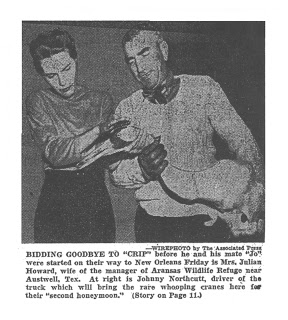Last Sunday in Crane Love Part Three, captive whooping cranes Jo and Crip hatched the first-ever captive chick. The little fellow was named Rusty.
Bob Allen believed the salvation of the species lay in the discovery of their nesting site in Canada. If whooping cranes reproduced in captivity, they would eventually become non-migratory and, in the true sense of the word, no longer wild. But being a team player, Allen was willing to give the whooping crane captive-breeding project a shot.
On the third day of Rusty’s life, Allen watched as the chick ran across Crip’s feet and stabbed at his father’s bill, ready to be fed. Allen wrote in his journal, “Then Crip bent over with a soft and graceful tenderness, and finding the tiny mouth with the tip of his great bill, fed him. In all my experience with birds, this was the most wonderful, and the most moving scene I have ever witnessed.”
By the end of that joyous day, Jo and Crip sent out alarm calls. Through the scope of a rifle, Allen noticed raccoons scurrying near the nest. A storm blew in that night preventing the Whooper Snooper team from investigating the site. The next morning, Jo and Crip were standing by an empty
nest, agitated. When they finally abandoned it, Allen entered the enclosure and his worst fears had come true. Rusty had disappeared.
More than sixteen hundred visitors from across North America visited the Aransas National Wildlife Refuge that year to view the two captive cranes which represented hope for the future of their species. The following year, Jo and Crip were enclosed in a smaller area surrounded by barbed wire and an electric fence to deter predators. Jo laid two eggs that spring. Flood waters washed them away. What followed was a battle between the refuge and the Audubon Zoo in New Orleans over who had legal ownership of the crane pair. Zoo superintendent, George Douglass, wanted the cranes returned to Louisiana while refuge manager, Julian Howard, insisted they stay in Texas. He was quoted as saying, “Douglass couldn’t get Jo or Crip with a fight.” Howard lost the fight and Jo and Crip were moved to the zoo. They lived together in a much smaller area than was allotted them at the refuge. Finally after five years, Jo laid two eggs. Both hatched. The cranes went on to produce thirteen hatchlings during their time together; four grew to adulthood; none reproduced. In 1965, Jo died in a hurricane that swept through Louisiana. Crip was transferred to the San Antonio Zoo where he mated with several females over the ensuring years. A few whooping cranes were produced, some lived, most didn’t. Crip died of natural causes on March 27, 1979.
When Rusty disappeared in 1950, radio stations across the country announced the loss. The story was picked up internationally. One citizen from Greenville, South Caroline, wrote a to the local newspaper. His heartrending plea read; “We read and exclaim about the little whopper, forget him the minute his disappears and all the while the National Audubon Society is struggling to provide sanctuaries in appropriate places where not only whooping cranes but other birds, threatened with extinction, may have some natural privacy and protection to make a comeback.”

That struggle still continues today. To read about current recovery plans to increase the population of whooping cranes, check out the epilogue of my book, The Man Who Saved the Whooping Crane: The Robert Porter Allen Story (University Press of Florida) released in September 2012. I like to describe the book as Indiana Jones meets John J. Audubon.
The book has been nominated for:
George Perkins Marsh Award for environmental history
Washington State Book Award for history/general nonfiction.
Contact me if your Audubon chapter, nature center, library, or birding club is interested in having me present a program on the story of the whooping cranes and the ornithologist who helped save them from extinction.
Check out these other whooping crane links:
Operation Migration: http://www.operationmigration.org/
Whooping Crane Conservation Association: http://whoopingcrane.com/
Whooping Crane: The Journey North: http://www.learner.org/jnorth/crane/
Check out these other whooping crane links:
Operation Migration: http://www.operationmigration.org/
Whooping Crane Conservation Association: http://whoopingcrane.com/
Whooping Crane: The Journey North: http://www.learner.org/jnorth/crane/


